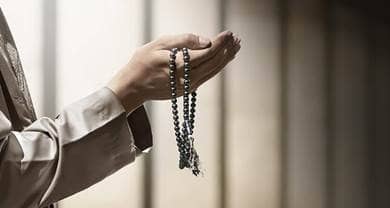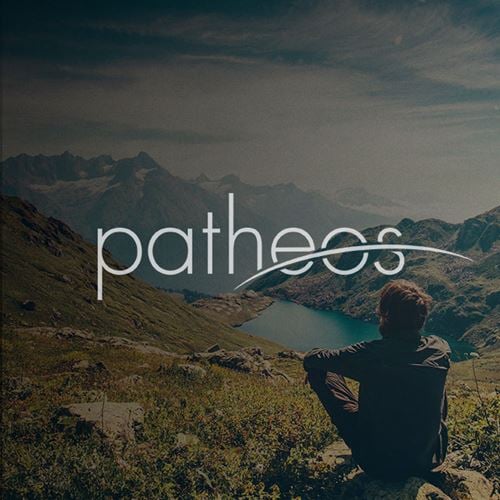- Trending:
- Pope Leo Xiv
- |
- Israel
- |
- Trump
- |
- Social Justice
- |
- Peace
- |
- Love

RELIGION LIBRARY
Shia Islam
Symbolism
There are several symbols of Shiite religiosity that can be displayed in everyday life. Connected to Muhammad's family, they are often not exclusive to Shiites, but particularly prominent among these Muslims.
A prominent symbol is Dhu l-fiqar, the bifurcated sword of Ali, which is worn, for example, on necklaces. It also appears in poetry to symbolize Ali's bravery, in calligraphy in connection with the name Ali or the Arabic letters lam and mim (particularly significant in letter mysticism), or to mark a level in Sufi hierarchies. Several stories circulate that account for its origin. According to one version, the sword was given to Ali by Muhammad and an audible voice said that "there is no brave young except for Ali and there is no sword except for Dhu l-fiqar," a play on the Islamic profession of faith. Another version has it that the sword was brought down from heaven by Gabriel—a parallel to the Quran, which the archangel brought down to Muhammad.
A symbol that also enjoys popularity in non-Shiite regions of the Islamic world, notably North Africa, is the hand of Fatima (khamsa), which, like Ali's sword, is believed to protect from the evil eye. According to the Shiite tradition, the five fingers symbolize Muhammad, Fatima, Ali, Hasan, and Husayn as well as the severed hand of Abbas when he tried to get water from the Euphrates for Husayn and his companions.
Green and black turbans are a distinctive Shiite symbol that is restricted to descendants of Muhammad. Prominent Shiite clerics such as the recently deceased Lebanese Fadlallah, who descended from Hasan, and the Iraqi scholar Sistani can be seen wearing black turbans. In taziyah plays, the heroes wear green as the color of paradise, while the villains wear red to suggest that their clothes are soaked with the blood of the martyrs.
Even though there is a long tradition of painting human figures in the Islamic world, such images are largely absent from Sunni sacred spaces. Decorative traditions in mosques often rely on calligraphy, and the names of Muhammad, Ali, Fatima, Hasan, Husayn, or only Ali are often displayed in Shiite sacred buildings, where pictures of Muhammad and Ali are also sometimes displayed. Sometimes they are present in invocations such as the frequently uttered Ya Ali (Arabic for O Ali). Other calligraphies use the names of God or Quranic verses referring to the Imams. These names and verses as well as prayers are attributed with magical power. They can be found on profane objects too such as astrolabes.
In the modern world, popular art showing scenes from early Islamic history flourishes. While pre-modern manuscripts already contained illustrations of Ali, images in a distinctly modern, often kitsch style proliferate in print and on the internet. A black-bearded youthful Husayn is shown wearing a green turban and accompanied by a white horse. Awaiting a violent death himself, he is sometimes shown grieving for his infant son Ali Asghar or his teenage son Ali Akbar.
The Muharram processions reveal an elaborate symbolism with small details reminding the participants of specific events. Symbols connected with weddings allude to Qasim ibn Hasan, a son of the second Imam who was engaged to Husayn's daughter Fatima Kubra. Alams (standards) are often dedicated to individual people such as the bifurcated sword, which refers to Ali, or a water skin, referring to Husayn's half-brother Abbas who died during the attempt to bring water from the Euphrates for his young nephews who were denied water on their deathbeds by the Umayyads. As part of the same symbolism, people give water during these processions. In Hyderabad, an alam dedicated to Qasim undergoes a "wedding ceremony" and is then treated as if it died, wrapped in a shroud, and buried. Participants want to demonstrate their conviction that if they had been in Karbala, they would not have abandoned Husayn and his family as the Kufans did.
The Iranian Revolution of 1979 offers an unusual case of elaborate Shiite symbolism as part of official political culture. In the opposition against Muhammad Reza Shah Pahlavi (1919-1980) Shiite symbolism became intertwined with socialist iconography. Thus, Ali Shariati (1933-1977), a sociologist of religion and intellectual revolutionary, compared Husayn and the Argentinean Marxist Che Guevara in his socialist interpretation of Islam. The messianic features of Marxism may have made these ideologies of the left particularly appealing in a Shiite context.
Political posters were a popular medium of political propaganda, in particular considering the level of illiteracy. In the absence of any previous indigenous tradition, these too often used the style of Socialist realism combined with elements of Iranian miniature painting and iconography (such as mythical figures from the Shahnameh, the famous epic of Iranian mythology and history composed by the Persian poet Ferdowsi in the 10th century). Graphic artists have produced impressive examples of political posters and murals during the war against Iraq with the aims of mobilizing the nation and commemorating the martyrs.
Another noteworthy example of Shiite symbolism is the mausoleum outside Tehran where the revolutionary leader Ayatollah Khomeini is buried. The traditional architecture resembles that of shrines for Imams (for example, the golden dome), and the terminology used to describe the funeral presents further parallels. Khomeini was even referred to as imam, even though the apocalyptic expectations connected with the revolution were only implicit.
Study Questions:
1. What is the Dhu l-fiqar and why is it important?
2. How do descendants of Muhammad display their heritage?
3. What connections have been made in modern times between Shiite political symbolism and other political traditions?










